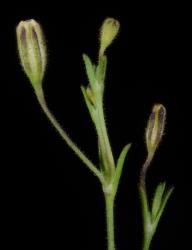- Taxon
- Gallery
Annual, with slender to ± stout taproot. Flowering stems erect, densely glandular-viscid, sparsely branched, 2–10–(15) cm tall. Lvs linear-subulate, subacute, glandular-viscid, green to reddish, (2.5)–7–15 × 0.5–1 mm; basal lvs in a tufted rosette. Infl. a monochasial or dichasial cyme with 5–10–(20) fls. Bracts leaflike, not scarious. Calyx cylindric to narrowly bell-shaped, glandular-viscid, 4–5 mm long, divided to c. 1/4 way; teeth triangular, subacute to acute with broad scarious margins. Petals white or pink, slightly > calyx, emarginate. Styles included, incurving. Capsule cylindric, c. = calyx. Seeds 0.7 × 0.5 mm, finely warty.
[From: Webb et al. (1988) Flora of New Zealand. Volume 4.]
Flowering: Nov.–Mar.–(May); Fruiting: Nov.–Mar.–(May)




